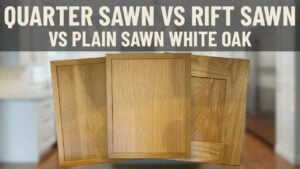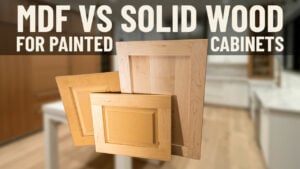Video Transcript
It's a glorious day at Cabinet Joint.
I'm Nick, and I'm here to talk to you about how wood color changes with age and by species to species.
So today, I've got a couple of examples set here. This example here is going to be of cherry—similar stain. However, this being a brand-new sample just received in 2025 versus an older sample that predates 2020.
As you can see, there's quite a bit of darkening that happens, particularly with cherry. Uh, the more natural stain that you go with, uh, the darker the color change seems to get. Now, this change is gradual over time. This isn't something where I install my, my project, these cabinets go in, and all of a sudden tomorrow they look a different color. It is really a long process. But we do want you to be aware: when you end up choosing a lighter wood, in a lot of cases they, they tend to darken, and some of the darker species tend to lighten.
So a good example of that would be walnut. Walnut tends to come out dark and then actually softens over the years. Cherry goes the other way. It's still technically a light wood, so that tends to darken. Your maples—they'll tend to almost give, almost like a yellow tint to it over time. I don't have a good example of the hard maple, but it really is going to be dependent upon which stain you end up going with.
So, one of the ways that I've combed that, even here in my office, is this is actually all cherry as well. You notice the contrast of natural cherry versus a stained cherry. And the reason I went with this is that, over time, if that darkens it becomes more chocolaty, as opposed to bringing out some of those reddish tints that you see in this example here.
So, there's ways that you could maybe make some decisions on the front end knowing full well that, you know, cherrywood darkens. You know, another good example of this would be in white oak. Everybody loves white oak right now, and there's a lot of variation even within that species of color—from browns to even really light, uh, tones.
Um, so one of the ways that we've combed that issue is that we'll put on a, a slightly lighter stain to it to kind of soften the feel, and it tends to give a more uniform color. Now, um, every species you can't, can't quite do that. Here's some natural hickory. You can see just hickory as a species has great variation from sapwood to heartwood. You'll see lots of variation and darker pieces to very, very, very light pieces. So in hickory you tend to get a little bit more of that yellowing over time. Uh, but again, I think if you, if you choose the right stain option, I think you can mitigate some of the color variation.
Color Change Due to UV Exposure
One of the reasons that wood changes color over time is primarily due to UV exposure. So, much like we would get sunburned, or you would leave even a paint color or your vehicle—depending on the level of UV exposure—it's going to accelerate the color change process. So, in lighter woods turning a little bit more yellow or even darkening over time, or in the darker woods softening, becoming lighter, almost fading in the UV light.
Combating Color Change
Some of the ways in which we can combat color change would be utilizing our many different finishing options—from a natural stain, to a just a clear coat, or even incorporating some glazes, um, may either, uh, accelerate or, or slow down that, that process. Like, when you add a glaze to any of our stained options, um, you're going to reduce how drastic of a change that color would be. So there's many tools to employ, many different options to choose from.
Summary
Um, but we still feel strongly that using a solid wood, using a North American harvested hardwood, uh, is still the best option—knowing full well that there's going to be some variation and it will age with you. But it's a natural product. This is wood. Uh, we're sequestering carbon for the life of that, that product. It's, uh, more environmentally friendly. It's, um, you know, more allergen-friendly than some of the other alternative materials out there.
And so we love our hardwoods, and, um, we want you to keep using them. But you, you do have to understand that there will be some, some color fluctuation during the life of that product.
Again, if you have any questions, happy to talk more about it: 888-211-6482.
Have a great day.




